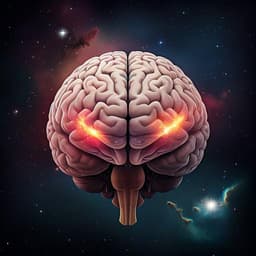
Space Sciences
Zero gravity induced by parabolic flight enhances automatic capture and weakens voluntary maintenance of visuospatial attention
A. Salatino, C. Iacono, et al.
Explore the fascinating world of microgravity! Research conducted by Adriana Salatino and colleagues reveals how microgravity influences our attention systems, enhancing automatic visuospatial attention while diminishing voluntary focus. This could transform our understanding of cognitive functions during space exploration and rehabilitation.
~3 min • Beginner • English
Introduction
Spatial attention enables selection of relevant stimuli and anticipation of events to guide action. Orienting attention involves both automatic/exogenous (stimulus-driven) and voluntary/endogenous (goal-directed) components and engages the vestibular system. The vestibular otolith organs encode head position relative to gravity; in microgravity their input is unweighted, providing a unique context to probe vestibular contributions to attention. Prior microgravity studies suggest increased reliance on visual information and enhanced visual processing, but how microgravity affects visuospatial attention—particularly its automatic versus voluntary components—remains unclear. The authors hypothesized that temporary unweighting of otolith input during parabolic flight would boost automatic, stimulus-driven attentional capture due to heightened visual salience, while leaving voluntary orienting unchanged. They tested this by comparing performance across gravity conditions using exogenous and endogenous Posner cueing tasks.
Literature Review
Neuropsychological and vestibular studies indicate that both exogenous and endogenous attention engage vestibular mechanisms (e.g., Corbetta & Shulman 2002; Dieterich & Brandt 2018). Microgravity studies (parabolic and orbital) have shown increased weighting of visual over vestibular inputs and enhancements in certain aspects of visual processing (Clément et al.), but evidence on visuospatial attention changes is limited and mixed, and no previous work dissociated effects on automatic versus voluntary attention. Theoretical models distinguish dorsal (goal-directed) and right-lateralized ventral (stimulus-driven) attention networks with distinct but interacting roles; vestibular projections overlap with regions such as TPJ and parietal areas implicated in these networks. This background motivated examining how otolith unweighting might differentially modulate these attention systems.
Methodology
Design: Within-subjects comparison across four conditions: 1 g before flight (PRE), 0 g during parabolic flight (0G), 1 g intervals during flight (1G), and 1 g after flight (POST). Participants performed exogenous and endogenous Posner cueing tasks in each condition.
Participants: Seven healthy right-handed volunteers (5 males, 2 females; mean age 35.83 ± 11.2 years; education 19 ± 1.4 years), normal or corrected vision, medically cleared for parabolic flight. All provided informed consent and received scopolamine preflight (0.25 mg/mL; 0.7 mL males, 0.5 mL females) to mitigate motion sickness. One participant experienced motion sickness during the first series of parabolas; their data for the endogenous task were excluded, and a backup participant completed only the exogenous task. Due to technical/data loss constraints, main analyses were conducted on five participants with complete datasets across conditions.
Parabolic flight protocol: ESA 72nd Parabolic Flights Campaign (Nov 2019) onboard Airbus A310 Zero-G (Bordeaux-Mérignac, France). Each flight included 30 parabolas (6 series × 5), each providing ~22 s of 0 g, with 1.8 g pull-up/pull-out phases (~23–24 s). Five-minute 1 g intervals occurred between series (8 min between the first 3 and last 3 series). Two participants were tested per flight; task order was counterbalanced. During tasks, participants sat cross-legged, strapped to the floor, 60 cm from a 17-inch laptop screen fixed to the floor; an operator supervised from the side.
Tasks and stimuli: Visual stimuli presented via E-Prime. Participants responded with left/right mouse buttons to indicate detection/location of a peripheral target (0.3° dot) appearing within one of two lateral boxes (1° × 1°), centered ±8° from fixation. They were instructed to maintain central fixation throughout blocks.
Exogenous task: Peripheral non-informative cues were realized by transient thickening of one box contour (0.05° to 0.14°). SOA = 100 ms. Validity: 50% valid, 50% invalid. Each session: 5 blocks; each block contained 8 valid and 8 invalid trials in random order. In 0G, each block was timed to the 0 g phase of a parabola; in 1G intervals, blocks were delivered during the 5-min breaks.
Endogenous task: Central informative arrow cue replaced fixation. SOA = 500 ms. Validity: 80% valid, 20% invalid (participants informed of cue predictiveness). Each session: 5 blocks; each block had 14 trials in random order. Block timing mirrored exogenous task across gravity conditions.
Dependent measures: Reaction time (RT) to correct responses and accuracy. Outlier handling: RTs <100 ms (anticipations) or >1000 ms excluded.
Statistical analysis: For each task, repeated-measures ANOVAs on accuracy and RTs with within-subject factors validity (valid, invalid) and condition (PRE, 0G, 1G, POST). Normality verified (Shapiro–Wilk). Alpha = 0.05 (two-tailed). Post hoc comparisons via Newman–Keuls. Effect sizes reported as partial η². Analyses performed with SPSS v26 and Statistica v12.
Key Findings
- Accuracy: High in both tasks (exogenous mean accuracy >94%; endogenous >93%); no significant main effects or interactions on accuracy.
- Reaction times: A validity effect (valid faster than invalid) was present in both tasks.
• Exogenous task: Main validity effect F1,490 = 149, P = 0.001, partial η² = 0.958. Mean RTs: valid 328.58 ± 51.19 ms; invalid 388.39 ± 41.35 ms. Validity × condition interaction F3,12 = 4.688, P = 0.022, partial η² = 0.540. Post hoc: Valid trials were faster in 0G than PRE (P = 0.0002), 1G (P = 0.0003), and POST (P = 0.0002). Invalid trials were slower in POST than PRE (P = 0.027), 0G (P = 0.005), and 1G (P = 0.040). Validity effect (invalid − valid) was larger in 0G versus PRE (P = 0.027) and 1G (P = 0.021), with a trend versus POST (P = 0.055).
• Endogenous task: Main validity effect F1,490 = 18.712, P = 0.012, partial η² = 0.824. Mean RTs: valid 272.01 ± 35.36 ms; invalid 331.32 ± 40.05 ms. Validity × condition interaction F3,12 = 6.809, P = 0.006, partial η² = 0.630. Post hoc: Invalid trials were faster in 0G than PRE (P = 0.0008), 1G (P = 0.033), and POST (P = 0.022); invalid trials were slower in PRE than 1G (P = 0.020) and POST (P = 0.030). No significant differences for valid trials across conditions. Validity effect was smaller in 0G than PRE (P = 0.006), 1G (P = 0.015), and POST (P = 0.011).
- Summary: Microgravity increased the magnitude of exogenous cueing (enhanced stimulus-driven attentional capture) and decreased endogenous cueing effects (faster disengagement from endogenously cued locations), with overall accuracy preserved. A fatigue-related slowing of invalid exogenous trials was observed in POST.
Discussion
The persistence of validity effects in 0 g indicates intact operation of attention systems during otolith unweighting. However, the divergent modulation—enhanced exogenous cueing and reduced endogenous cueing—suggests that vestibular signals differentially impact automatic versus voluntary attention. In 0 g, heightened visual salience likely boosts stimulus-driven capture, accelerating engagement at valid exogenously cued locations. Conversely, reduced otolith input may impair maintenance of voluntary attention at cued locations, facilitating disengagement from invalid endogenously cued positions. Neural accounts align with distinct dorsal (goal-directed) and ventral (stimulus-driven) attention networks and their vestibular projections: overlap of vestibular inputs with the right-lateralized ventral network (e.g., TPJ, supramarginal and angular gyri) and projections to superior colliculus could modulate egocentric reference frames and multisensory integration. In microgravity, weakened egocentric anchoring and relatively stronger stimulus-centered or allocentric processing may increase perceived salience, enhancing exogenous capture at the expense of top-down control. The study’s design, with 1 g measurements before and after 0 g, mitigates confounds from parabolic flight adaptation, practice, or scopolamine pharmacodynamics. Operationally, strengthened automatic orienting and weakened voluntary maintenance in 0 g may contribute to astronauts’ altered spatial perceptions (e.g., size and distance misestimation, looming illusions) and to increased cognitive fatigue by drawing attention toward salient peripheral stimuli and away from ongoing goal-directed tasks. Findings also inform vestibular-related rehabilitation strategies on Earth.
Conclusion
This study demonstrates that transient otolith unweighting during parabolic flight selectively enhances automatic, stimulus-driven attentional capture while weakening voluntary maintenance of covert attention, without degrading overall accuracy. The results clarify vestibular contributions to distinct attention systems and provide a framework for anticipating and mitigating cognitive-operational challenges in microgravity. Future research should disentangle egocentric versus allocentric reference frame contributions under altered gravity, incorporate direct measures of eye fixation and multisensory integration, extend sample sizes, and assess longer-duration microgravity to evaluate persistence and adaptation of these effects. Translational work could explore countermeasures and rehabilitation protocols targeting vestibular-attention interactions for spaceflight and clinical populations with vestibular or spatial awareness disorders.
Limitations
- Parabolic flight context may introduce unspecific effects of weightlessness that could distract participants; although such distraction would be expected to impair performance broadly, selective effects cannot be entirely excluded.
- Small effective sample size for main analyses (n = 5 with complete datasets) due to motion sickness in one participant and technical data loss in another condition, limiting generalizability and statistical power.
- Potential fatigue effects, evidenced by slowing of invalid exogenous trials in the POST condition, may have influenced some comparisons.
- Use of scopolamine preflight could have residual effects despite design controls; pharmacological influences cannot be fully ruled out.
Related Publications
Explore these studies to deepen your understanding of the subject.







